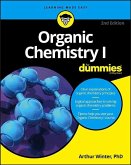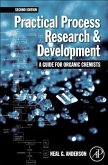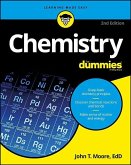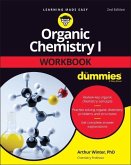Eusebio Juaristi (Centro de Investigacion y de Estudios Avanzados d, C. Gabriela Avila-Ortiz (Centro de Investigacion y de Estudios Avan, Alberto Vega-Penaloza
Basic Concepts of Orbital Theory in Organic Chemistry
Eusebio Juaristi (Centro de Investigacion y de Estudios Avanzados d, C. Gabriela Avila-Ortiz (Centro de Investigacion y de Estudios Avan, Alberto Vega-Penaloza
Basic Concepts of Orbital Theory in Organic Chemistry
- Broschiertes Buch
- Merkliste
- Auf die Merkliste
- Bewerten Bewerten
- Teilen
- Produkt teilen
- Produkterinnerung
- Produkterinnerung
Increase your understanding of molecular properties and reactions with this accessible textbook The study of organic chemistry hinges on an understanding and capacity to predict molecular properties and reactions. Molecular Orbital Theory is a model grounded in quantum mechanics deployed by chemists to describe electron organization within a chemical structure. It unlocks some of the most prevalent reactions in organic chemistry. Basic Concepts of Orbital Theory in Organic Chemistry provides a concise, accessible overview of this theory and its applications. Beginning with fundamental concepts…mehr
Andere Kunden interessierten sich auch für
![Free Energy Relationships in Organic and Bio-Organic Chemistry Free Energy Relationships in Organic and Bio-Organic Chemistry]() Andrew Williams (UK University of Kent)Free Energy Relationships in Organic and Bio-Organic Chemistry57,99 €
Andrew Williams (UK University of Kent)Free Energy Relationships in Organic and Bio-Organic Chemistry57,99 €![Organic Chemistry I for Dummies Organic Chemistry I for Dummies]() Arthur Winter (University of Maryland, College Park, MD)Organic Chemistry I for Dummies25,99 €
Arthur Winter (University of Maryland, College Park, MD)Organic Chemistry I for Dummies25,99 €![Practical Process Research and Development - A Guide for Organic Chemists Practical Process Research and Development - A Guide for Organic Chemists]() Neal G. AndersonPractical Process Research and Development - A Guide for Organic Chemists86,99 €
Neal G. AndersonPractical Process Research and Development - A Guide for Organic Chemists86,99 €![Enzyme-Based Organic Synthesis Enzyme-Based Organic Synthesis]() Cheanyeh ChengEnzyme-Based Organic Synthesis206,99 €
Cheanyeh ChengEnzyme-Based Organic Synthesis206,99 €![Chemistry for Dummies Chemistry for Dummies]() John T. MooreChemistry for Dummies24,99 €
John T. MooreChemistry for Dummies24,99 €![The Organic Chem Lab Survival Manual The Organic Chem Lab Survival Manual]() James W. ZubrickThe Organic Chem Lab Survival Manual85,99 €
James W. ZubrickThe Organic Chem Lab Survival Manual85,99 €![Organic Chemistry I Workbook for Dummies Organic Chemistry I Workbook for Dummies]() Arthur Winter (University of Maryland, College Park, MD)Organic Chemistry I Workbook for Dummies29,99 €
Arthur Winter (University of Maryland, College Park, MD)Organic Chemistry I Workbook for Dummies29,99 €-
-
-
Increase your understanding of molecular properties and reactions with this accessible textbook The study of organic chemistry hinges on an understanding and capacity to predict molecular properties and reactions. Molecular Orbital Theory is a model grounded in quantum mechanics deployed by chemists to describe electron organization within a chemical structure. It unlocks some of the most prevalent reactions in organic chemistry. Basic Concepts of Orbital Theory in Organic Chemistry provides a concise, accessible overview of this theory and its applications. Beginning with fundamental concepts such as the shape and relative energy of atomic orbitals, it proceeds to describe the way these orbitals combine to form molecular orbitals, with important ramifications for molecular properties. The result is a work which helps students and readers move beyond localized bonding models and achieve a greater understanding of organic chemical interactions. In Basic Concepts of Orbital Theory in Organic Chemistry readers will also find: * Comprehensive explorations of stereoelectronic interactions and sigmatropic, cheletropic, and electrocyclic reactions, * Detailed discussions of hybrid orbitals, bond formation in atomic orbitals, the Hückel Molecular Orbital Method, and the conservation of molecular orbital symmetry * Sample exercises for organic chemistry students to help reinforce and retain essential concepts Basic Concepts of Orbital Theory in Organic Chemistry is ideal for advanced undergraduate and graduate students in chemistry, particularly organic chemistry.
Produktdetails
- Produktdetails
- Verlag: John Wiley & Sons Inc
- Seitenzahl: 288
- Erscheinungstermin: 11. August 2025
- Englisch
- Abmessung: 242mm x 167mm x 14mm
- Gewicht: 564g
- ISBN-13: 9781394253845
- ISBN-10: 1394253842
- Artikelnr.: 72176668
- Herstellerkennzeichnung
- Libri GmbH
- Europaallee 1
- 36244 Bad Hersfeld
- gpsr@libri.de
- Verlag: John Wiley & Sons Inc
- Seitenzahl: 288
- Erscheinungstermin: 11. August 2025
- Englisch
- Abmessung: 242mm x 167mm x 14mm
- Gewicht: 564g
- ISBN-13: 9781394253845
- ISBN-10: 1394253842
- Artikelnr.: 72176668
- Herstellerkennzeichnung
- Libri GmbH
- Europaallee 1
- 36244 Bad Hersfeld
- gpsr@libri.de
Eusebio Juaristi, PhD, is Professor at Centro de Investigacion de Estudios Avanzados del Instituto Politecnico Nacional, Mexico City, Mexico.He has produced influential research in numerous areas of physical organic chemistry, particularly conformational analysis and stereochemistry, as well as computational chemistry, asymmetric organocatalysis, and sustainable chemistry. C. Gabriela Ávila-Ortiz, PhD, is a Research Assistant at Centro de Investigacion de Estudios Avanzados del Instituto Politecnico Nacional, Mexico City, Mexico. She works in Professor Juaristi's research group studying the asymmetric synthesis of organic compounds, organocatalysis, and green chemistry. Alberto Vega-Peñaloza, PhD, is Serra Hunter Lecturer in the Section of Organic Chemistry at the University of Barcelona, Spain. He has worked as Senior Scientist I at Selvita S.A., Poland, as a postdoctoral fellow at the Faculty of Chemistry of the National Autonomous University of Mexico (UNAM), as a postdoctoral researcher at ICIQ in Spain, and at the University of Padova, Italy, where he was awarded the Seal of Excellence UniPD grant to work on the development of photocatalytic systems for sustainable synthetic methods.
Preface ix Chapter 1 Introduction and History of the Molecular Orbital Theory 1 Introduction 1 Nature of Electromagnetic Radiation 2 The Wave Nature of Light 3 Electromagnetic Spectrum 5 The Distinction Between Energy and Matter 6 The Particle Nature of Light 7 Mass and Momentum Associated with a Light Quantum 11 Wave-Particle Duality 13 Application of Quantum Mechanics to Atomic Structure 14 Schrödinger's Equation 19 Hydrogenic Orbitals 23 Why Doesn't the Electron Fall into the Nucleus? Bohr's Legacy and the Quantum Mechanical Model 32 Further Reading 33 Exercises 34 Chapter 2 Hybrid Orbitals 35 Introduction 35 Hybridisation Theory 37 Wavefunctions Associated with Hybrid Orbitals 42 Procedure to Build a Hybrid Orbital 43 Orthogonality of Wave Functions (Orbitals) 44 The Bent Bond or Tau Model 45 Effects of Hybridisation 45 Further Reading 51 Exercises 51 Chapter 3 Bond Formation from Atomic Orbitals 53 Introduction 53 Mixing of s Orbitals 53 Mixing of p Orbitals 58 Factors Affecting the Magnitude of Orbital Interactions 60 Bonding in Homo-Diatomic Molecules 62 Bonding in Hetero-Diatomic Molecules 68 Bonding in Triatomic Molecules 72 Conjugated Systems 84 Further Reading 84 Exercises 84 Chapter 4 The Hückel Molecular Orbital Method (HMO) 85 The Linear Combination of Atomic Orbitals (LCAO) Method 85 The Hückel Molecular Orbital (HMO) Method 86 Simplified Procedure for the Application of Hückel
s Method 91 Application of Hückel
s Method: Several Examples 92 Application to Larger Molecules 96 Scope and Limitations of the Hückel Molecular Orbital Method 97 Hückel Molecular Orbital Method in Cyclic
-Systems 97 Energy Diagrams for Acyclic Polyenes 101
-Systems Containing Heteroatoms 102 Inclusion of Overlap Between Vicinal Atoms 106 The Shape of the Molecular Orbitals 108 Contribution of the AOs in a Molecular Orbital 108 Symmetry Simplifications in Alternant Hydrocarbons 112 Estimation of MO Energies and Coefficients 115 Bond Orders
(
P
ij )
116 Charge Distribution (
q
I ) 118 Index of Free Valence (
f
I ) 119 Further Reading 120 Exercises 121 Chapter 5 Interactions Between Molecular Orbitals: Chemical Reactions 123 Introduction 123 Molecular Orbital Theory of Selected Organic Reactions 127 Summary 140 Further Reading 141 Exercises 141 Chapter 6 Some Applications of Orbital Theory in Organic Chemistry 143 Introduction 143 Ultraviolet Spectroscopy 143 Ionisation Potentials 146 Photoelectron Spectroscopy (PES) 147 Interactions Between
Orbitals 148 Interactions Between n-Orbitals 151 Electron Spectroscopy for Chemical Analysis (ESCA) Spectroscopy 155 Charge Transfer Complexes (EDA Complexes) 155 Further Reading 156 Exercises 157 Chapter 7 Conservation of Molecular Orbital Symmetry: Introduction to Pericyclic Reactions - Cycloaddition Reactions 159 Introduction 159 Concerted Reactions 160 Pericyclic Reactions 161 Principles of the Conservation of Orbital Symmetry 164 Symmetry Correlation Diagrams of Molecular Orbitals 164 Analysis of the Symmetry of the HOMO/LUMO Frontier Orbitals (FMO) 168 Analysis of the Nodal Properties at the Transition State of a Cyclisation Reaction 169 Cycloaddition Reactions 172 1,3-Butadiene + Ethylene
Cyclohexene 173 Two Ethylene Molecules
Cyclobutane 175 Supra- or Antarafacial Topicity in Cycloaddition Reactions 179 Effect of Secondary Interactions Between Molecular Orbitals 180 Further Reading 182 Exercises 182 Chapter 8 Cheletropic Reactions 185 Introduction 185 [2 + 2] Cheletropic Reactions 186 [4 + 2] Cheletropic Reactions 190 [6 + 2] Cheletropic Reactions 194 Further Reading 196 Exercises 196 Chapter 9 Electrocyclic Reactions 199 Introduction 199 1,3-Butadiene
Cyclobutene 201 1,3,5-Hexatriene
1,3-Cyclohexadiene 204 Photochemical Electrocyclic Reactions 207 Further Reading 210 Exercises 210 Chapter 10 Sigmatropic Reactions 213 Introduction 213 [3,3] Sigmatropic Rearrangements 216 [1,3] Sigmatropic Rearrangements of Alkyl Groups 218 Analysis of Nodal Properties in the Transition State 221 [1,5] Sigmatropic Rearrangements of Alkyl Groups 221 [1,2] Sigmatropic Rearrangements of Alkyl Groups 225 [1,3] Sigmatropic Rearrangements of Hydrogen 227 [1,5] Sigmatropic Rearrangements of Hydrogen 228 Further Reading 231 Exercises 232 Chapter 11 1,3-Dipolar Cycloadditions 235 Introduction 235 Classification of 1,3-Dipolar Reactants 235 Frontier Molecular Orbital Analysis 236 Analysis of Nodal Properties in the Transition State 238 Types of 1,3-DPCA Reactions and Regioselectivity 239 1,3-DPCA Reactions with Diazoalkanes 242 1,3-DPCA Reactions with Nitrones 243 1,3-DPCA Reactions with Azomethine Ylides as the 1,3-Dipolar Reactant 245 1,3-DPCA Reactions with Nitrile Oxides as 1,3-Dipolar Reactants 247 1,3-DPCA Reactions with Azides, Osmium Tetroxide and Ozone 248 Further Reading 251 Exercises 251 Chapter 12 Stereoelectronic Interactions 255 Introduction 255 Interpretation of the anomeric effect 258 Stereoelectronic interactions in S-C-P segments 261 Further Reading 266 Exercises 267 Index 269
s Method 91 Application of Hückel
s Method: Several Examples 92 Application to Larger Molecules 96 Scope and Limitations of the Hückel Molecular Orbital Method 97 Hückel Molecular Orbital Method in Cyclic
-Systems 97 Energy Diagrams for Acyclic Polyenes 101
-Systems Containing Heteroatoms 102 Inclusion of Overlap Between Vicinal Atoms 106 The Shape of the Molecular Orbitals 108 Contribution of the AOs in a Molecular Orbital 108 Symmetry Simplifications in Alternant Hydrocarbons 112 Estimation of MO Energies and Coefficients 115 Bond Orders
(
P
ij )
116 Charge Distribution (
q
I ) 118 Index of Free Valence (
f
I ) 119 Further Reading 120 Exercises 121 Chapter 5 Interactions Between Molecular Orbitals: Chemical Reactions 123 Introduction 123 Molecular Orbital Theory of Selected Organic Reactions 127 Summary 140 Further Reading 141 Exercises 141 Chapter 6 Some Applications of Orbital Theory in Organic Chemistry 143 Introduction 143 Ultraviolet Spectroscopy 143 Ionisation Potentials 146 Photoelectron Spectroscopy (PES) 147 Interactions Between
Orbitals 148 Interactions Between n-Orbitals 151 Electron Spectroscopy for Chemical Analysis (ESCA) Spectroscopy 155 Charge Transfer Complexes (EDA Complexes) 155 Further Reading 156 Exercises 157 Chapter 7 Conservation of Molecular Orbital Symmetry: Introduction to Pericyclic Reactions - Cycloaddition Reactions 159 Introduction 159 Concerted Reactions 160 Pericyclic Reactions 161 Principles of the Conservation of Orbital Symmetry 164 Symmetry Correlation Diagrams of Molecular Orbitals 164 Analysis of the Symmetry of the HOMO/LUMO Frontier Orbitals (FMO) 168 Analysis of the Nodal Properties at the Transition State of a Cyclisation Reaction 169 Cycloaddition Reactions 172 1,3-Butadiene + Ethylene
Cyclohexene 173 Two Ethylene Molecules
Cyclobutane 175 Supra- or Antarafacial Topicity in Cycloaddition Reactions 179 Effect of Secondary Interactions Between Molecular Orbitals 180 Further Reading 182 Exercises 182 Chapter 8 Cheletropic Reactions 185 Introduction 185 [2 + 2] Cheletropic Reactions 186 [4 + 2] Cheletropic Reactions 190 [6 + 2] Cheletropic Reactions 194 Further Reading 196 Exercises 196 Chapter 9 Electrocyclic Reactions 199 Introduction 199 1,3-Butadiene
Cyclobutene 201 1,3,5-Hexatriene
1,3-Cyclohexadiene 204 Photochemical Electrocyclic Reactions 207 Further Reading 210 Exercises 210 Chapter 10 Sigmatropic Reactions 213 Introduction 213 [3,3] Sigmatropic Rearrangements 216 [1,3] Sigmatropic Rearrangements of Alkyl Groups 218 Analysis of Nodal Properties in the Transition State 221 [1,5] Sigmatropic Rearrangements of Alkyl Groups 221 [1,2] Sigmatropic Rearrangements of Alkyl Groups 225 [1,3] Sigmatropic Rearrangements of Hydrogen 227 [1,5] Sigmatropic Rearrangements of Hydrogen 228 Further Reading 231 Exercises 232 Chapter 11 1,3-Dipolar Cycloadditions 235 Introduction 235 Classification of 1,3-Dipolar Reactants 235 Frontier Molecular Orbital Analysis 236 Analysis of Nodal Properties in the Transition State 238 Types of 1,3-DPCA Reactions and Regioselectivity 239 1,3-DPCA Reactions with Diazoalkanes 242 1,3-DPCA Reactions with Nitrones 243 1,3-DPCA Reactions with Azomethine Ylides as the 1,3-Dipolar Reactant 245 1,3-DPCA Reactions with Nitrile Oxides as 1,3-Dipolar Reactants 247 1,3-DPCA Reactions with Azides, Osmium Tetroxide and Ozone 248 Further Reading 251 Exercises 251 Chapter 12 Stereoelectronic Interactions 255 Introduction 255 Interpretation of the anomeric effect 258 Stereoelectronic interactions in S-C-P segments 261 Further Reading 266 Exercises 267 Index 269
Preface ix Chapter 1 Introduction and History of the Molecular Orbital Theory 1 Introduction 1 Nature of Electromagnetic Radiation 2 The Wave Nature of Light 3 Electromagnetic Spectrum 5 The Distinction Between Energy and Matter 6 The Particle Nature of Light 7 Mass and Momentum Associated with a Light Quantum 11 Wave-Particle Duality 13 Application of Quantum Mechanics to Atomic Structure 14 Schrödinger's Equation 19 Hydrogenic Orbitals 23 Why Doesn't the Electron Fall into the Nucleus? Bohr's Legacy and the Quantum Mechanical Model 32 Further Reading 33 Exercises 34 Chapter 2 Hybrid Orbitals 35 Introduction 35 Hybridisation Theory 37 Wavefunctions Associated with Hybrid Orbitals 42 Procedure to Build a Hybrid Orbital 43 Orthogonality of Wave Functions (Orbitals) 44 The Bent Bond or Tau Model 45 Effects of Hybridisation 45 Further Reading 51 Exercises 51 Chapter 3 Bond Formation from Atomic Orbitals 53 Introduction 53 Mixing of s Orbitals 53 Mixing of p Orbitals 58 Factors Affecting the Magnitude of Orbital Interactions 60 Bonding in Homo-Diatomic Molecules 62 Bonding in Hetero-Diatomic Molecules 68 Bonding in Triatomic Molecules 72 Conjugated Systems 84 Further Reading 84 Exercises 84 Chapter 4 The Hückel Molecular Orbital Method (HMO) 85 The Linear Combination of Atomic Orbitals (LCAO) Method 85 The Hückel Molecular Orbital (HMO) Method 86 Simplified Procedure for the Application of Hückel
s Method 91 Application of Hückel
s Method: Several Examples 92 Application to Larger Molecules 96 Scope and Limitations of the Hückel Molecular Orbital Method 97 Hückel Molecular Orbital Method in Cyclic
-Systems 97 Energy Diagrams for Acyclic Polyenes 101
-Systems Containing Heteroatoms 102 Inclusion of Overlap Between Vicinal Atoms 106 The Shape of the Molecular Orbitals 108 Contribution of the AOs in a Molecular Orbital 108 Symmetry Simplifications in Alternant Hydrocarbons 112 Estimation of MO Energies and Coefficients 115 Bond Orders
(
P
ij )
116 Charge Distribution (
q
I ) 118 Index of Free Valence (
f
I ) 119 Further Reading 120 Exercises 121 Chapter 5 Interactions Between Molecular Orbitals: Chemical Reactions 123 Introduction 123 Molecular Orbital Theory of Selected Organic Reactions 127 Summary 140 Further Reading 141 Exercises 141 Chapter 6 Some Applications of Orbital Theory in Organic Chemistry 143 Introduction 143 Ultraviolet Spectroscopy 143 Ionisation Potentials 146 Photoelectron Spectroscopy (PES) 147 Interactions Between
Orbitals 148 Interactions Between n-Orbitals 151 Electron Spectroscopy for Chemical Analysis (ESCA) Spectroscopy 155 Charge Transfer Complexes (EDA Complexes) 155 Further Reading 156 Exercises 157 Chapter 7 Conservation of Molecular Orbital Symmetry: Introduction to Pericyclic Reactions - Cycloaddition Reactions 159 Introduction 159 Concerted Reactions 160 Pericyclic Reactions 161 Principles of the Conservation of Orbital Symmetry 164 Symmetry Correlation Diagrams of Molecular Orbitals 164 Analysis of the Symmetry of the HOMO/LUMO Frontier Orbitals (FMO) 168 Analysis of the Nodal Properties at the Transition State of a Cyclisation Reaction 169 Cycloaddition Reactions 172 1,3-Butadiene + Ethylene
Cyclohexene 173 Two Ethylene Molecules
Cyclobutane 175 Supra- or Antarafacial Topicity in Cycloaddition Reactions 179 Effect of Secondary Interactions Between Molecular Orbitals 180 Further Reading 182 Exercises 182 Chapter 8 Cheletropic Reactions 185 Introduction 185 [2 + 2] Cheletropic Reactions 186 [4 + 2] Cheletropic Reactions 190 [6 + 2] Cheletropic Reactions 194 Further Reading 196 Exercises 196 Chapter 9 Electrocyclic Reactions 199 Introduction 199 1,3-Butadiene
Cyclobutene 201 1,3,5-Hexatriene
1,3-Cyclohexadiene 204 Photochemical Electrocyclic Reactions 207 Further Reading 210 Exercises 210 Chapter 10 Sigmatropic Reactions 213 Introduction 213 [3,3] Sigmatropic Rearrangements 216 [1,3] Sigmatropic Rearrangements of Alkyl Groups 218 Analysis of Nodal Properties in the Transition State 221 [1,5] Sigmatropic Rearrangements of Alkyl Groups 221 [1,2] Sigmatropic Rearrangements of Alkyl Groups 225 [1,3] Sigmatropic Rearrangements of Hydrogen 227 [1,5] Sigmatropic Rearrangements of Hydrogen 228 Further Reading 231 Exercises 232 Chapter 11 1,3-Dipolar Cycloadditions 235 Introduction 235 Classification of 1,3-Dipolar Reactants 235 Frontier Molecular Orbital Analysis 236 Analysis of Nodal Properties in the Transition State 238 Types of 1,3-DPCA Reactions and Regioselectivity 239 1,3-DPCA Reactions with Diazoalkanes 242 1,3-DPCA Reactions with Nitrones 243 1,3-DPCA Reactions with Azomethine Ylides as the 1,3-Dipolar Reactant 245 1,3-DPCA Reactions with Nitrile Oxides as 1,3-Dipolar Reactants 247 1,3-DPCA Reactions with Azides, Osmium Tetroxide and Ozone 248 Further Reading 251 Exercises 251 Chapter 12 Stereoelectronic Interactions 255 Introduction 255 Interpretation of the anomeric effect 258 Stereoelectronic interactions in S-C-P segments 261 Further Reading 266 Exercises 267 Index 269
s Method 91 Application of Hückel
s Method: Several Examples 92 Application to Larger Molecules 96 Scope and Limitations of the Hückel Molecular Orbital Method 97 Hückel Molecular Orbital Method in Cyclic
-Systems 97 Energy Diagrams for Acyclic Polyenes 101
-Systems Containing Heteroatoms 102 Inclusion of Overlap Between Vicinal Atoms 106 The Shape of the Molecular Orbitals 108 Contribution of the AOs in a Molecular Orbital 108 Symmetry Simplifications in Alternant Hydrocarbons 112 Estimation of MO Energies and Coefficients 115 Bond Orders
(
P
ij )
116 Charge Distribution (
q
I ) 118 Index of Free Valence (
f
I ) 119 Further Reading 120 Exercises 121 Chapter 5 Interactions Between Molecular Orbitals: Chemical Reactions 123 Introduction 123 Molecular Orbital Theory of Selected Organic Reactions 127 Summary 140 Further Reading 141 Exercises 141 Chapter 6 Some Applications of Orbital Theory in Organic Chemistry 143 Introduction 143 Ultraviolet Spectroscopy 143 Ionisation Potentials 146 Photoelectron Spectroscopy (PES) 147 Interactions Between
Orbitals 148 Interactions Between n-Orbitals 151 Electron Spectroscopy for Chemical Analysis (ESCA) Spectroscopy 155 Charge Transfer Complexes (EDA Complexes) 155 Further Reading 156 Exercises 157 Chapter 7 Conservation of Molecular Orbital Symmetry: Introduction to Pericyclic Reactions - Cycloaddition Reactions 159 Introduction 159 Concerted Reactions 160 Pericyclic Reactions 161 Principles of the Conservation of Orbital Symmetry 164 Symmetry Correlation Diagrams of Molecular Orbitals 164 Analysis of the Symmetry of the HOMO/LUMO Frontier Orbitals (FMO) 168 Analysis of the Nodal Properties at the Transition State of a Cyclisation Reaction 169 Cycloaddition Reactions 172 1,3-Butadiene + Ethylene
Cyclohexene 173 Two Ethylene Molecules
Cyclobutane 175 Supra- or Antarafacial Topicity in Cycloaddition Reactions 179 Effect of Secondary Interactions Between Molecular Orbitals 180 Further Reading 182 Exercises 182 Chapter 8 Cheletropic Reactions 185 Introduction 185 [2 + 2] Cheletropic Reactions 186 [4 + 2] Cheletropic Reactions 190 [6 + 2] Cheletropic Reactions 194 Further Reading 196 Exercises 196 Chapter 9 Electrocyclic Reactions 199 Introduction 199 1,3-Butadiene
Cyclobutene 201 1,3,5-Hexatriene
1,3-Cyclohexadiene 204 Photochemical Electrocyclic Reactions 207 Further Reading 210 Exercises 210 Chapter 10 Sigmatropic Reactions 213 Introduction 213 [3,3] Sigmatropic Rearrangements 216 [1,3] Sigmatropic Rearrangements of Alkyl Groups 218 Analysis of Nodal Properties in the Transition State 221 [1,5] Sigmatropic Rearrangements of Alkyl Groups 221 [1,2] Sigmatropic Rearrangements of Alkyl Groups 225 [1,3] Sigmatropic Rearrangements of Hydrogen 227 [1,5] Sigmatropic Rearrangements of Hydrogen 228 Further Reading 231 Exercises 232 Chapter 11 1,3-Dipolar Cycloadditions 235 Introduction 235 Classification of 1,3-Dipolar Reactants 235 Frontier Molecular Orbital Analysis 236 Analysis of Nodal Properties in the Transition State 238 Types of 1,3-DPCA Reactions and Regioselectivity 239 1,3-DPCA Reactions with Diazoalkanes 242 1,3-DPCA Reactions with Nitrones 243 1,3-DPCA Reactions with Azomethine Ylides as the 1,3-Dipolar Reactant 245 1,3-DPCA Reactions with Nitrile Oxides as 1,3-Dipolar Reactants 247 1,3-DPCA Reactions with Azides, Osmium Tetroxide and Ozone 248 Further Reading 251 Exercises 251 Chapter 12 Stereoelectronic Interactions 255 Introduction 255 Interpretation of the anomeric effect 258 Stereoelectronic interactions in S-C-P segments 261 Further Reading 266 Exercises 267 Index 269








